
August 9, 2021
Navigating Back-To-School Season with Mindfulness
The other night at dinner, I asked a friend how she felt about her son attending in-person classes for the first time after a year of Zoom school. She didn’t hesitate: “I’m anxious,” she said.
Aside from the ambient worry over whether her son might catch COVID-19, she worried whether the Delta variant would force a redo of online schooling. She also was waiting for information on logistics: Would students at her son’s large, public high school go back all at once, have a staggered schedule, or would a hybrid of in-person and online learning be offered?
As our conversation continued over pasta, it became clear just how unclear back-to-school season is this year.
Federal, state, and county COVID-19 protocols and those for many school districts are changing as often as a cafeteria lunch menu. And all of it is making this back-to-school season particularly fraught.
While many families feel helpless to prepare, the perspectives and practices of mindfulness can help parents and children cope with ongoing uncertainty and the ups and downs a new school year brings.
Here are some practical ways mindfulness can help you and your children stay flexible, grounded, and even a bit more joyful as another school year is underway amid an ongoing pandemic.
Practice Mindfulness Together
As someone who teaches mindfulness to children and teens, other parents often ask me how they can get their kids to practice mindfulness. My first suggestion is for parents to practice mindfulness themselves and then model it for their kids. I still stand by that answer. But there are many light-hearted and fun ways for families to practice mindfulness together. And doing so offers opportunities for parents and kids to connect, de-stress, and focus on what’s good in their lives. The following gratitude practice can be done anytime, anywhere and can help parents and children shift their attention away from what’s problematic to what’s positive in their lives. One tip for parents: It usually backfires when we make mindfulness an agenda or something our kids have to do. Often a better approach is to invite your kids to practice along with you. Share the following as something you’ve found helpful and make it into a fun activity or even a family ritual to do whenever you feel too focused on the negative instead of the positive. (Elementary and middle school children might enjoy this activity more than teens.)
Five-Finger Gratitude Practice
Stand or sit facing your partner. Hold up your hand with fingers spread wide like a starfish. Ask whomever you’re doing the game with to name something they’re grateful for – a person, an object, a place, an experience. After they say what they’re thankful for, your partner folds down your pinky finger. The activity continues with your partner naming another thing they’re grateful for and then folding down your ring finger. The game continues until your partner has named five things they’re thankful for, and all fingers fold into a soft fist that you can place on your heart or the heart of your partner. Switch roles and play the game again. As you do the activity, notice what positive emotions arise and bring your attention to them, savoring the warmth of gratitude that may emerge from the practice.
Check Yourself Before You Wreck Yourself
Mindfulness is a powerful tool for learning when our stress levels are too high. Checking in with ourselves throughout the day by taking a moment to feel our breath, notice sensations in our body, or tune into the mental chatter in our minds helps us gauge where we are on the stress continuum. Checking ourselves before wrecking ourselves also helps us manage our stress when it’s arising, whether related to the back-to-school season or anything else.
Next time you feel overwhelmed, practice STOP: Stop, Take a Breath, Observe and Proceed. The first step in the Stop practice is to literally stop whatever it is your doing. Then, take a breath. Observe what’s happening in your body and your mind.If you feel overwhelmed, gently ask yourself what you need to feel more balanced. And if your children ask you what you’re doing, tell them you’re practicing a micro-moment of mindfulness so you can be steady and ready for whatever might come next. As mentioned above, modeling mindfulness for your kids is a helpful way for them to develop the same skills. One tip for parents: The STOP practice can be made into a fun activity with your kids by practicing it on the drive to school or soccer practice whenever you see a STOP sign. (For kids of all ages.)
Talk Frequently and Often
How your child feels about going back to school might change from one day to the next or one moment to the next. Frequently checking in with your child can reveal new insights and help you gauge their mental, emotional and physical wellbeing.
It’s also an opportunity to seamlessly weave mindfulness into your daily life by practicing mindful listening. When we’re in a conversation, we’re often planning what we want to say or, in the case of our kids, what we want them to do. When we listen mindfully, we put our plans on hold and devote our attention to whoever is speaking, tuning into ourselves occasionally to notice when we’ve become distracted, reactive, or gone into planning mode.
For kids, mindful listening can create a welcome and connected space that encourages them to share what’s on their minds. And the more we practice mindful listening; the more our kids are often willing to share. Next time you start a conversation with your child, take a breath and settle in. Open your ears and your heart to whatever they have to say.
Written by Kelly Barron
Resources:
The Kaiser Family Foundation: https://www.kff.org/coronavirus-covid-19/issue-brief/mental-health-and-substance-use-considerations-among-children-during-the-covid-19-pandemic/
Prepping for Back to School: https://www.cdc.gov/coronavirus/2019-ncov/community/schools-childcare/parent-checklist.html#:~:text=Talk%20with%20your%20child%20about,changes%20in%20your%20child.
Children’s Mental Health: https://www.cdc.gov/childrensmentalhealth/symptoms.html